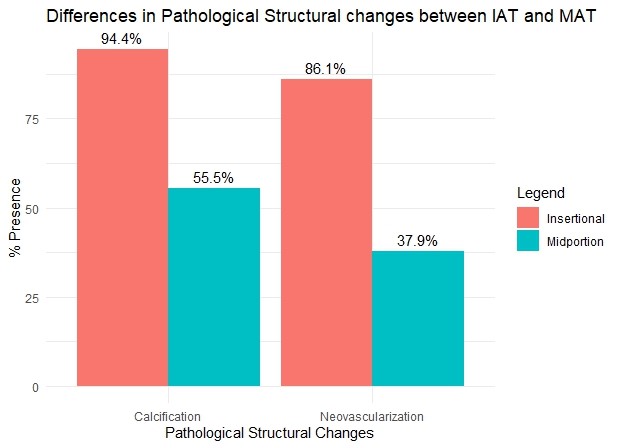Session Information
Session Type: Poster Session C
Session Time: 10:30AM-12:30PM
Background/Purpose: Achilles tendinopathy is the clinical diagnosis of a painful injury to the Achilles tendon associated with pain during tendon loading and structural changes within the tendon. Achilles tendinopathy can be defined as either insertional (IAT, within 2 cm proximal of calcaneal insertion) or midportion (MAT, 2-7cm proximal to calcaneal insertion) Achilles tendinopathy. Both of these injuries are treated with progressive loading via exercise as the gold standard treatment, however up to 68% of those with IAT and 40% of those with MAT continue to have symptoms following exercise treatment. The reason for worse outcome with exercise for individuals with IAT may be due to IAT having additional pathological structural changes that do not respond to exercise treatment. Intratendinous calcifications and neovascularization are structural changes within the tendon associated with tendinopathy. Therefore, the purpose of the study was to examine if there were differences in the presence of calcifications or neovascularization between individuals with insertional and individuals with midportion Achilles tendinopathy.
Methods: 36 participants with IAT (18F, 49 ± 12.1y, 30.9 ± 6.0 kg/m2) and 182 participants with MAT (103F, 47 ± 12.7y, 28.8 ± 6.2 kg/m2) were included in this analysis of 3 ongoing studies. The presence of calcifications and neovascularization were assessed using ultrasound imaging with B-mode and Power Doppler (GE Logic e). The Victorian Institute of Sport – Assessment Achilles (VISA-A) was used to assess patient symptom severity and is scored 0 – 100 with 100 being asymptomatic. Paired t-tests were used to compare groups.
Results: There were significant differences in the presence of calcifications (94.4% IAT, 55.5% MAT, p < 0.001), and neovascularization between groups (86.1% IAT, 37.9% MAT, p < 0.001). There was no significant difference in the VISA-A scores between groups (48 ± 16.3 IAT, 50 ± 17.8 MAT, p = 0.539).
Conclusion: Individuals with IAT had a greater prevalence of additional pathological structural changes within the tendon than those with MAT, despite no difference in symptom severity. These findings build upon the current literature describing pathology differences between these injuries and may provide insight into potential targets for therapeutic interventions to not only improve symptomatic recovery, but also structural recovery of the Achilles tendon.
To cite this abstract in AMA style:
Smith A, Powell Smitheman H, Silbernagel K. Insertional and Midportion Achilles Tendinopathy Have Differences in Presence of Calcifications and Neovascularization [abstract]. Arthritis Rheumatol. 2024; 76 (suppl 9). https://acrabstracts.org/abstract/insertional-and-midportion-achilles-tendinopathy-have-differences-in-presence-of-calcifications-and-neovascularization/. Accessed .« Back to ACR Convergence 2024
ACR Meeting Abstracts - https://acrabstracts.org/abstract/insertional-and-midportion-achilles-tendinopathy-have-differences-in-presence-of-calcifications-and-neovascularization/

